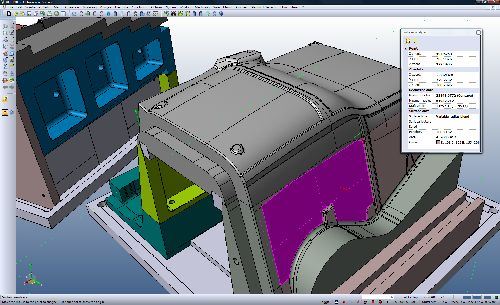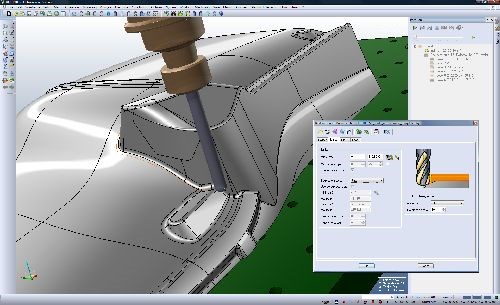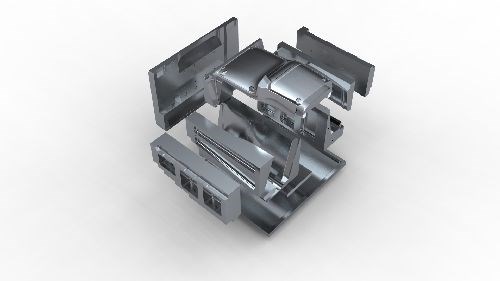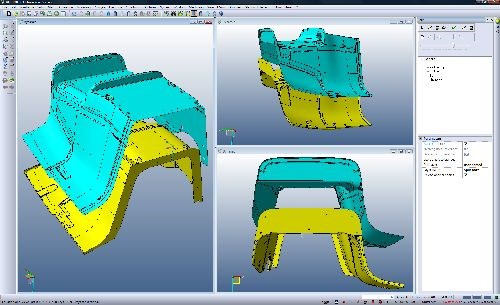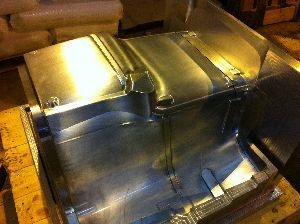Design Collaboration Produces Tooling Right First Time
DeltaCAD Ltd collaborates with sub contract tooling manufacturer Casting Support Systems on a project to provide a leading aerospace company with aluminum tooling for a carbon composite seat shell for a major civil airline company.
Devon based DeltaCAD Ltd, a start-up company that specializes in CAD/CAM services collaborated with sub contract tooling manufacturer Casting Support Systems Ltd on a project to provide a leading aerospace company with aluminium tooling for a carbon composite seat shell for a major civil airline company.
The volatile nature of fuel prices has forced the aerospace industry to make weight reduction a high priority focus and reducing the weight of aircraft seating significantly reduces aviation fuel consumption and CO2 emissions throughout the operational lifetime of the aircraft.
DeltaCAD Ltd was founded in 2010 by Dean Challis, a design engineer with considerable CAD/CAM and tool design experience, who provides a comprehensive range of design and manufacturing services from 2D drawings to 3D modelling and CAM programming.
For this project, the original CAD model was provided by the customer as a Unigraphics NX file and the part analysis and tool design was performed using VISI Modelling from Vero Software.
"VISI is very tolerant of non-native data," explains Dean Challis. "Often when models are originally designed, the manufacturing requirements are not always known. To make a part manufacturable, it is vital to interact with the data and make the relevant changes. In regards to these particular components and with authority from the original design team, the tooling was modified to remove undercut areas and apply blend radii on sharp edges. Typically, blending can be a very complex task and it is often necessary to explode a model into surfaces and manually apply the CAD modifications. VISI is very strong at switching between a solid and surface environment and this allows us to make complex changes where other CAD systems often fall over."
The manufacture of the tooling was performed by Casting Support Systems, a company that supplies large tooling to the investment casting, plastic molding and gas turbine industries; but also, in conjunction with its sister company Versa-tote, is a forerunner in the design and manufacture of returnable transit boxes, picking and order tote boxes for distribution and storage facilities across Europe.
All toolpaths were programmed using VISI Machining and the aluminium tooling was milled using XYZ 1060 high speed vertical machining centres running Siemens 840D ShopMill Control, with WNT solid carbide end mills which have been specifically designed for cutting softer materials such as aluminium. The geometry of the tooling makes it possible to cut full slots to 1.5 x D depth with high feed rates, typically twice that of traditional steel cutting tools. The tooling life for the cutters is approximately 3,000 hours.
The entire multi surface tool was manufactured and assembled in only 9 days and this was partly due to optimal toolpath usage and running multiple jobs at the same time.
Sam Cox, Toolroom Foreman at Casting Support Systems explains, "Complex tools often contain a number of sub inserts where the setup time is disproportionate to the actual CAM runtime. To overcome this obstacle, we setup a number of individual jobs located around a single datum which run overnight for lights-out machining. Although the machine can run at optimum production rates, we back off when running overnight to protect tool life. We use VISI to accurately predict the actual toolpath cutting time and program accordingly. A typical set of overnight programs will run for up to 14 hours."
The carbon fiber material used was a 2 x 2 twill weave cloth that is pre-impregnated with epoxy resin so that when the tool is brought up to temp (120-140 degrees depending on resin used) the resin cures within approximately 1 hour. The tool is then cooled as quickly as possible and the top half of the tool is removed, exposing the carbon fiber molding. The properties of carbon fiber such as high tensile strength, low weight, and low thermal expansion make it very popular in aerospace, civil engineering, military and competition sports.
The complete assembled, multi insert tooling was sent to our customer for lay-up and production where the final carbon fiber component (measuring 700mm x 680mm x 460mm) weighed only 5.25 lbs was 'right first time having virtually no visible split line definition'.
Although Casting Support Systems Ltd already have in-house CAD/CAM capabilities, Director, James Head acknowledges the benefits of using external design expertise from DeltaCAD and maximizing the use of VISI Machining. "The combination of Dean and VISI has catered for many additional requirements and has in fact exceeded our expectations. Vero have provided a powerful, cost effective solution for the design and manufacture of complex tooling."
Related Content
What is Driving Mold Lifecycle Management Digitalization?
OEMs are looking to partner with suppliers to share and track data across the supply chain for advanced intervention and process management.
Read MoreThe Role of Social Media in Manufacturing
Charles Daniels CFO of Wepco Plastics shares insights on the role of social media in manufacturing, how to improve the “business” side of a small mold shop and continually developing culture.
Read MoreWhat is Scientific Maintenance? Part 2
Part two of this three-part series explains specific data that toolrooms must collect, analyze and use to truly advance to a scientific maintenance culture where you can measure real data and drive decisions.
Read MoreMMT Chats: The Connection Between Additive Manufacturing Education and ROI
This MMT Chat continues the conversation with Action Mold and Machining, as two members of the Additive Manufacturing team dig a little deeper into AM education, AM’s return on investment and the facility and equipment requirements to implement AM properly.
Read MoreRead Next
How to Use Strategic Planning Tools, Data to Manage the Human Side of Business
Q&A with Marion Wells, MMT EAB member and founder of Human Asset Management.
Read MoreHow to Use Continuing Education to Remain Competitive in Moldmaking
Continued training helps moldmakers make tooling decisions and properly use the latest cutting tool to efficiently machine high-quality molds.
Read MoreReasons to Use Fiber Lasers for Mold Cleaning
Fiber lasers offer a simplicity, speed, control and portability, minimizing mold cleaning risks.
Read More
